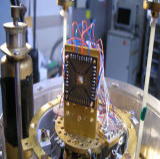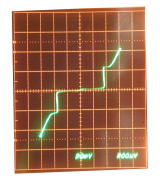Cosmic Microwave Background
Cosmic Microwave Background (CMB) is the most ancient light we can observe today. As the photons were isolated about13.7 billion years ago, they still carry the information of the earliest universe. Studying the CMB may give us hints on what gave birth to our universe and basic physical laws behind.
Our research team is developing highly sensitive superconducting detectors and their readout systems for the CMB polarization detection in collaboration with groups at KEK and RIKEN. Our research field expands from the very large scale physics of the cosmos to the microscopic superconductors and their applications.
What is CMB?
 |
| Figure 1.A photograph of antenna coupled STJ. The actural size is 5mm x 5mm. |
Immediately after the Big Bang the universe was a super hot world, where particles such as electrons, protons, neutrons, and photons swam around freely. Neutral atoms didn't exist then. When atoms were just beginning to form, high energy photons would ionize them. Photons repeated Thomson scatterings with free electrons, so there was a little visibility. The universe was at a dense foggy state. As the universe expanded and became colder, the photon energies were decreased. Then about 380 thousand years after the Big Bang, they didn’t have enough energies to ionize neutral atoms. That meant that the electrons were trapped by protons and neutral hydrogen atoms had begun to form. The photons were decoupled and could then travel far without being scattered off of electrons. Most of these photons are still travelling, far and many years later into the world we live now. We can see these photons: the oldest light we can observe. They come from far away, even further away from the most distant stars and galaxies. These photons exist everywhere in our cosmos at any point of its history, so they are called Cosmic Background Radiation. They are known to have about 2 mm wavelength, so they are sometimes called Cosmic Microwave Background.
What we have learned from CMB?
 |
| Figure 2. STJ is placed in the 3He cryostat, which can bee cooled down to 0.3K. |
CMB was discovered by Arno Penzias and Robert Wilson in 1965, and it led them to win a Nobel Prize in 1978. An American satellite mission COBE, launched in 1989, discovered that the CMB had a thermal black body spectrum at 2.7 K, and had 1/100,000 thermal fluctuations in all-sky. The former proved the Big Bang theory that predicted at the beginning the universe was a super-hot highly pressured big fireball. The latter was a discovery of the “seed” that constructed the grand mechanism of the universe as we know it. These achievements earned John Mather and George Smoot the 2006 Nobel Prize. In 2001, WMAP was launched to investigate the temperature fluctuation. WMAP’s measurements have determined that the universe is 13.7 billion years old, and 95% of it is composed of something mysterious: dark matter and dark energy.
What is in the future of CMB?
 |
| Figure 3.IV-curve of Al STJ. Horizontal axis is the applied voltage and the vertical is the resulting current through the STJ. The step shape shows the STJ is behaving as superconductor. |
The next step for us would be to detect polarization of the CMB. A photon propagates as magnetic field and electric field oscillate perpendicularly to each other and to the direction of the photon wave. If the electric field is biased in its direction, then the propagating light wave has polarization. CMB is known to have polarization, and all-sky survey of the CMB polarization shows two distinctive patterns which we call E-mode and B-mode. We have gained knowledge on re-ionization of the universe by the E-mode observation by WMAP with limited resolution. However B-mode, which is said to be made by primordial gravitational wave, is much smaller signal and not yet observed. WMAP will need 15 years to accumulate data for the B-mode measurement, but it is much longer than its planned operation period. Primordial gravitational waves are thought to be created during the period of inflation even before the Big Bang. If we can detect the wave, we may be able to solve the mystery of inflation; its energy scale or the mechanism of it. We may be able to peek through even further away than CMB.
How can we detect the polarization of CMB?
Only an extremely sensitive detector can detect such faint signals of polarized CMB. Our answer is superconducting devices. We are developing new types of sensors that are more sensitive than any existing devices to detect the millimeter-wave, in collaboration with groups at KEK and RIKEN. Superconductivity is carried by Cooper pairs, which are pairs of electrons. When radiated by external millimeter wave Cooper pairs break, and the radiation can be detected as current signal. We are developing new Superconducting Tunnel Junction (STJ) sensors utilizing this phenomenon.
What can we learn from this reseach?
We strive towards future detection of CMB polarization. To do that, we need knowledge of astrophysics as well as particle physics. In order to develop detectors and experiment with them, we must know electromagnetism, quantum mechanics, low temperature solid state physics, and their experimental techniques and applications such as superconducting devices and electronic circuitry. Physics of all fields need to be gathered.
If you want to peak at the furthest corner of our cosmos through microscopic detectors dominated by quantum effects, come and join us!